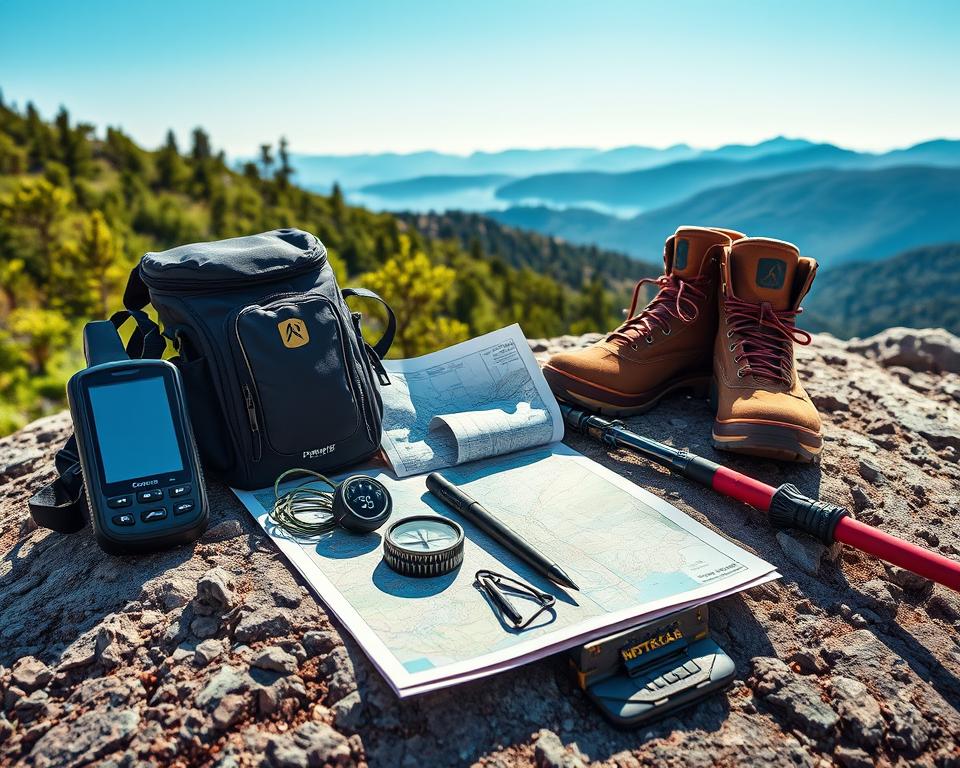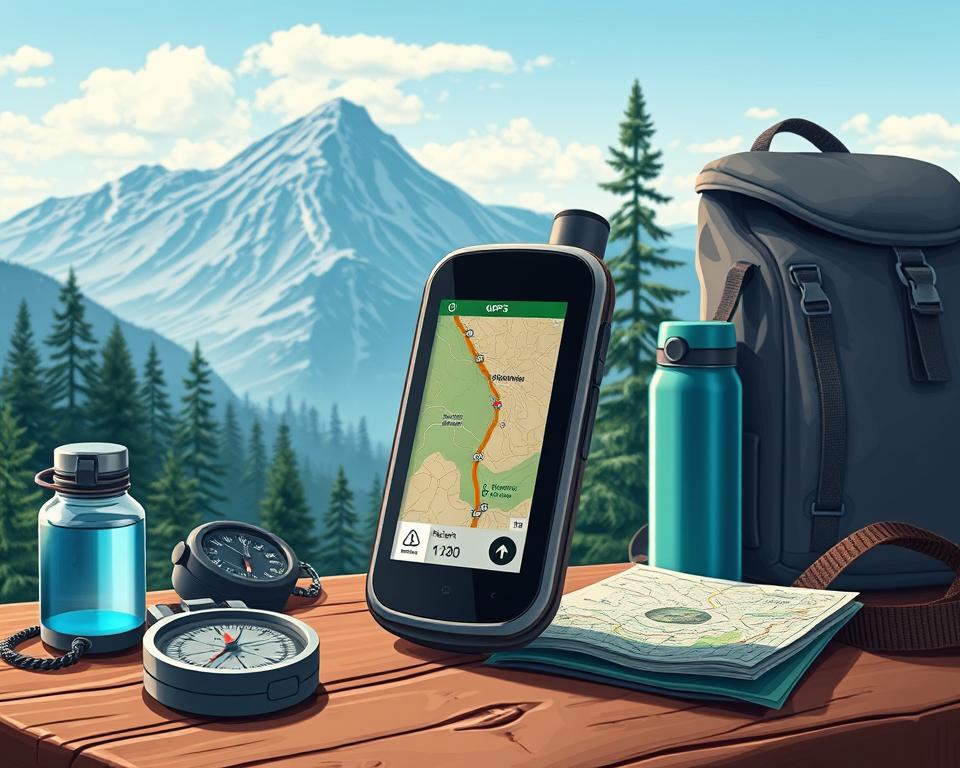The way we find our path outdoors has changed a lot. We used to look up at the stars or use a compass and map. Now, GPS technology makes our journeys safer and easier. This guide will show you how to set up your hiking GPS effectively. You’ll learn to prepare maps, follow trails right, and use landmarks and coordinates.
GPS trackers have changed hiking in recent years. Before, we used many old-school ways to find our way. Now, these modern gadgets give precise locations and directions. This means we’re less likely to get lost. From what I’ve found, important habits include checking where you are, using both GPS and the environment, and preparing well before you start.
Welcome to the basics of GPS for beginners. Knowing the fundamentals and benefits of GPS will set you up for success. It doesn’t matter if it’s your first hike or your hundredth. Using a GPS can really change the way you navigate trail guidance.
Why Use a Hiking GPS?
Going into the wild needs more than eagerness. Reliable tools for finding your way are a must. In the past, explorers used the sun and stars, then maps and compasses. Now, GPS technology has changed outdoor adventures, making it easier to know where you are.
The Evolution of Navigation
Navigation changed from watching the sky to using high-tech GPS. At first, stars guided the way. Then, compasses made map reading better. Now, GPS lets hikers know their exact spot, improving confidence and safety on trails.
GPS benefits shine in apps like Ramblers, offering over 4,000 walking paths. These tools make exploring outdoors safer and more fun.
Advantages Over Traditional Methods
Even with the value of old-school navigation, GPS has clear pluses. It’s more accurate, easy to use, and keeps you safe. Hikers with GPS devices find their way better, no matter the weather.
Yet, using GPS wrongly can cause problems. For example, in the San Bernardino mountains, misused GPS gadgets led to unneeded rescues. It’s key to use GPS wisely, alongside good map reading.
It’s important to mix GPS tech with traditional navigation. This approach keeps hikers safe and makes adventures more enjoyable.
How GPS Technology Works
For those who love hiking, knowing how GPS technology works is key. GPS, from the USA, is the best-known system in the Global Navigation Satellite Systems (GNSS). These systems use satellites to give precise locations. This helps a lot with navigation while hiking. Let’s explore how this technology and various factors impact its use in hiking GPS devices.
Understanding Satellite Systems
GPS technology relies on satellites orbiting Earth. There are many satellites, and they all send signals. Hiking GPS devices pick up these signals. By getting the timing right from four satellites, the GPS can tell where you are. Newer devices can use other systems like GLONASS, Galileo, and BeiDou too. This improves how well they work.
Accuracy Factors
Many things can affect how accurate your hiking GPS is. The landscape, like forests or canyons, can make it less precise. Buildings in cities can also block the signals. Weather conditions also matter. Things like heavy clouds or big storms can weaken the signals. Even solar flares from the sun can cause trouble.
But, new GPS units are much better now. They work well even when conditions are tough. Before you go hiking, make sure your GPS is ready. It should be charged, have enough storage, and all maps should be downloaded. Knowing about these factors and practicing with your GPS means you can explore confidently.
Beginner’s Guide to Using a Hiking GPS
Learning to use a GPS for hiking can make your outdoor trips better. A GPS has many benefits over old-school map and compass methods. It’s especially useful for those just starting out. Here are some key steps to follow.
Make sure your device is fully charged before you leave. Today, most devices, including smartphones, have GPS built-in. But, remember, smartphones may need extra care like waterproof cases to stay safe outdoors.
For simple location checking, try handheld units like the Garmin eTrek SE or the Zoleo Global Satellite Communicator. For a full navigation system, the Garmin GPSMap 67i with a big screen is good. Wearable GPS gadgets are perfect for tracking runs and more.
Before you hit the trail, load up your maps. GPS units usually have basic maps, but you might need detailed topography maps for hiking. Services like Gaia GPS provide comprehensive international and historical maps for adventurers everywhere.

Knowing how to use GPS data on the trail is crucial. Look at the land around you and use the compass feature to stay on course. Always match what you see on your GPS with the real land you’re walking on.
If you’re new to hiking with GPS, adjust your pace to match the land. Understand magnetic differences and pick the easiest paths. Expect to hike 2-3 miles an hour, adding extra time for climbing hills.
Always carry a physical map and compass as a backup. Though digital maps are great for planning and exploring, nothing beats having a backup. AllTrails says moderate hikes are 5-8 miles long with some uphill parts. It’s a good start for beginners.
For a detailed look at GPS for hiking, read this beginner’s guide to hiking. It tells you all you need to know about GPS hiking and the best GPS platforms to use.
How Can Trail Tips Enhance My Use of a Hiking GPS Effectively?
Navigating the great outdoors can be daunting for newcomers, but using hiking GPS effectively can transform your experience. By incorporating essential tips for beginners, like familiarizing yourself with the device and understanding trail maps, you’ll enhance your confidence and ensure a safer, more enjoyable adventure in nature.
Practical Tips for Hiking with GPS
Hiking with a GPS can make your journey safer and more enjoyable. As technology gets better, using GPS for hikes helps you find your way. But, there are a few things to remember. Here’s how to get the best from your GPS on your next trail.
Preparation Before the Trail
Getting ready for your hike is important. Make sure your GPS device is fully charged before you leave. Also, bring extra batteries or a power source. Knowing how to use your device and having maps ready are key. Don’t forget a physical map and compass just in case.
Navigation On the Trail
When you’re hiking, knowing how to use your GPS is crucial. Always check if it’s showing your correct location. Notice if the GPS directions match up with what you see around you. This not only guides you but helps you understand the area better, says a study by the British Mountaineering Council.
Utilizing Landmarks
Landmarks have long been important for navigation. Use them with your GPS to check if you’re going the right way. Guessing how long to get to your next point helps too. This method is handy where GPS signals might be weak, like in forests or canyons.
Backup Plans
Having a backup plan is always a good idea for hiking safety. If your GPS stops working, be ready with a map and compass. Learning to use these old-school tools well can really pay off. Remember, practice makes perfect in navigation, with or without GPS.

